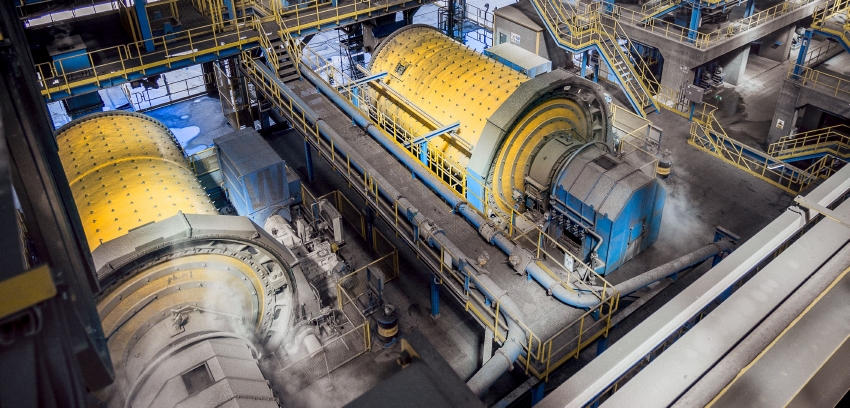We touched on the subject in the first post also by noting, that the root cause might be somewhere else than it first seems. The bottlenecks might result from factors not originating in the stage where issues are observed. They can be related to equipment, operations or ore characteristics. Quality assessments are an effective way to tackle the issue as a whole: to identify both the root cause and corrective actions as well.
Optimize, upgrade or replace
Mine operators can improve production by pushing existing equipment or through upgrades or replacements. A lot depends on the type of equipment and duty. Let’s go through some examples.
Gyratory crushers
While gyratory crushers aren’t usually upgraded in place, it can sometimes be done. This sparked the design of the Metso Outotec Superior™ MKIII primary gyratory crusher – more capacity for the exact footprint of either MKI or MKII but provides superior opex.
Cone crushers
In the case of a cone crusher, many Symons cone crushers have been replaced by Metso HP cones that fit in the footprint for seamless upgrades. This allows more production while keeping the original flowsheet without forcing significant changes to the auxiliary equipment.
SAG mills
Replacements are seldom done to SAG mills due to cost and also the constraints of other circuit equipment. Instead, often additional production lines are added. Also, if the bottleneck is the SAG mill, adding a pebble crusher can provide a small production boost (typically 5 to 10%).
Ball mills
For ball mills, replacement is less common. Often, after optimizing ball charge, liners and classification, the attention is to crush finer or add additional grinding, parallel to or after the existing mill. Parallel addition involves a significant step change in production.
Additional grinding in series may provide more incremental benefits: higher tonnes per hour (tph) but maintaining or improving fineness of grind. In the case of adding in series a more efficient comminution device should be considered. In the case of fine grinding, horizontal mills are not the most energy efficient devices. A stirred media device such as a Vertimill® or SMD® can provide extra grinding capacity more efficiently than conventional ball milling.
Operating with ore variation
Getting the most work out of equipment can be challenging. Performance can be improved through better production planning with the mine, understanding flowsheet effects of different ore types and improved controls.
Ore hardness
Ore hardness can be a major factor affecting plant production, depending on ore variability. In cases where there is minimal variation, bottlenecks do not often shift among unit operations. However, with highly variable ore, the operational philosophy should be considered. Ideally, with significant ore variation, the production planning should involve both mine and concentrator. That would enable ore blending to reduce feedstock variation or at least better inform operators regarding what ore characteristics to expect. All too often this is a missed opportunity to improve concentrator performance as mine and concentrator often work with limited coordination with each other.
Ore type
If there will be changes in ore type, one should assess how comminution circuits handle ore variation. In the case of a SAG and ball mill circuit either machine could be the bottleneck. Corrective actions depend on both circuit and how much ore variation is experienced. For example, when SAG limited and if there is a pebble crusher, the crusher closed side setting can be decreased. This is a common action when there is ore variability and bottleneck switches between SAG and ball mill. With more ore consistency, the circuit could be changed.
A possible circuit change would send the crusher discharge to the ball mill circuit, better balancing the work between the SAG and ball mill. When ball mill-limited and with low ore variability, a similar circuit modification redirecting flows can be done. It may be possible to redirect some of the ball mill hydrocyclone coarse fraction back to the SAG mill. More effective use of the existing grinding equipment through controls or circuit design can lift bottlenecks. If such approaches do not lift capacity acceptably, additional grinding equipment could be added but that is a more signification change.
Ore grade
Swings in ore grade result in very high fluctuations in mass flow in the regrinding circuit. This may result in coarser particle size and a lower concentrate grade, or, should no other acceptable action be available, even a reduction in concentrator feed rate. This is an example of where better coordination between mine and plant can improve plant performance.
Control systems can play an important role as well. Advanced process control strategies should identify the current limit and make changes that help balance the load and maximize utilization of circuit assets. Optimizing control logic handles ore type variations by looking at multiple constraints and rates of change of key variables in making control decisions. Generally, this can be done faster and to greater effect than manual adjustments.
The above discussion covered some ways to improve plant operations. Examples given were coordinating plant and mine production planning, altering flows around equipment and utilizing advanced process controls to better manage bottlenecks. Deploying these approaches can reap better performance from a plant.
This blog post is part of a three-piece series on how to increase plant production when it is already running at full capacity. The full series include:
1. Assessing processes for best value
2. Comminution circuit bottlenecks

